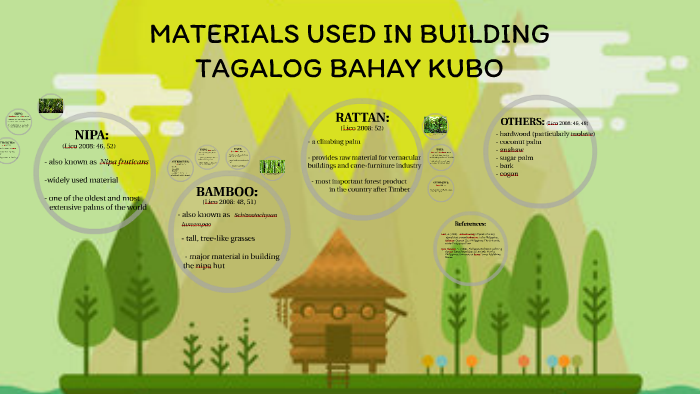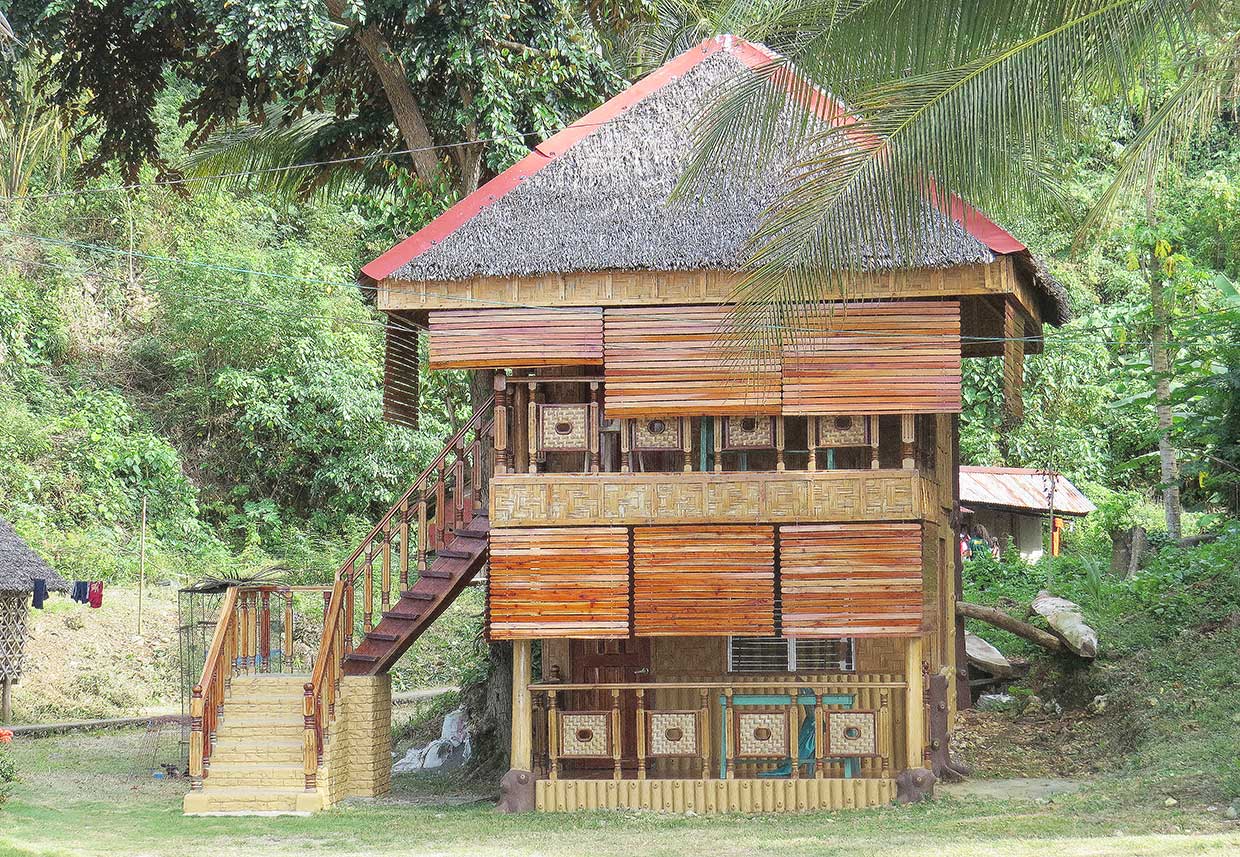Material used in bahay kubo - And to enhance the cozy vibe of the property Red Jun and Darleth Mae installed string lights in front of their home. The Bahay Kubo is the native house of the Philippines and is also considered as its national shelter.

Materials Used In Building Tagalog Bahay Kubo By Lian Layco
Material used in bahay kubo

Material used in bahay kubo. The name of the primitive Nipa hut is actually based on the Spanish phrase Cubo meaning cube probably because of its rectangular appearance and Bahay is the Filipino word for house. 5 Filipino Materials for a Bahay na Bato in Bulacan. Iloilo bahay kubo prices in the philippines like share subscribe for more videos.
Vela floor plan here. The most obvious difference between the two houses would be the materials that were used to build them. February 29 2020.
Lico 2008 48 - cut and woven in a herringbone pattern to form the walls - bound in dense rows onto the bamboo skeleton of the roof OTHERS. Made of indigenous building materials like bamboo tied together and covered with a thatched roof using nipaanahaw leaves. Materials used in building tagalog bahay kubo ipac-alarcon 2008.
Alistair built an industrial-contemporary take on the bahay kubo which features materials like palochina wood concrete and metal. Homeowners susan toots ople and fort location. Real Living reader Jane Santos sent us a message through our Facebook page to ask how she can update the façade of her family home.
A bahay kubo is in a shape of cubic were made of wood planks grass bamboo and large logs. Bahay na Bato is composed of a cement rock sand bamboos narra and some metals. Because they used mostly materials from the farm and pre-loved furniture from their parents they saved a lot on expenses.
Bahay na Bato or the Stone House is based on the Nipa Hut. Pick the materials youll work with. But the only Difference you can see is the materials used in the construction of the House.
In achieving a modern look on a bahay kubo -inspired structure wood can be combined with different elements such as concrete or metal. Modernizing the bahay kubo seems to be picking up on trends and were all here for it. The living area is outside the house with an open view of nature.
As for walls sawali and sawaling banig can be used framed with bamboo slats or. Bahay kubo or Nipa Hut is made of nipa and bamboo or otherwise indigenous materials. By Michelle Dumlao - Pastoral and Therese Dehesa Aug 6 2015.
Its roof can also be a nipa. Give a nod to the past and create your own take on the cultural symbol with these tips and reminders from the architect. Common materials used in modern Bahay Kubo construction include Wood Bamboo Nipa leaves.
MATERIALS USED IN BUILDING TAGALOG BAHAY KUBO Ipac-Alarcon 2008. A typical materials in building bahay kubo uses bamboo and wood for the beams and posta nipa shingles or pawid leaves for the roof and windows bamboo slats for flooring it can be elevated too railings and even for benches and stair steps. 65m x 6m prices 12.
Phileindesign products vela p392991947 house features. A Bahay Kubo is a kind of native house designed by our elders for some certain purposes it is made of indigenous building materials like bamboo and nipa this pre-hispanic Architecture was constructed to perfectly. All in all the Suminguits spent around P150000 for the construction of their modern bahay kubo.
Although they are the same folk houses and they are originally designed by our very own ancestor. The Bahay na Bato was constructed out of brick and stone rather than the traditional bamboo materials used in making the Bahay Kubo. Bahay kubo or nipa hut in English is a Filipino traditional dwelling place made of genuine green materials like nipa leaves for the roof and split bamboos for the wall and floor.
The Bahay Kubo is a pre-hispanic architecture was constructed to perfectly adapt to the tropical climate of the. Believe it or not but the humble bahay kubo an abode whose creation dates back to the pre-war period and which is commonly used today in rural areas is an archetype of an energy-efficient structure. Bamboo comprises 8090 percent of a bahay kuboThe material is very versatile used as strips split or whole timber varieties.
Unfairly given the moniker of poor mans lumber and relegated for use in furniture bags and wall décor bamboo has experienced a renaissance as a building material thanks to increased public interest in going green. The Bahay na bato the colonial Filipino house followed the nipa huts arrangements such as open ventilation and elevated apartments. Combining these materials can create a modern appearance.
Similar conditions in Philippine lowland areas have led to characteristics typical of examples of Bahay Kubo. This is a comparison and study between a Bahay Kubo and a Concrete House and how they provide the things to be considered for human needs. The bahay kubo is commonly made of wood bamboo strips and thatched roof.
There are many differences between the Bahay na Bato and Bahay Kubo the first one is the materials being used to construct the two different house. It is originally and is still typical for Bahay kubo to be mostly organic in material and be elevated mainly for vernacular and superstitious reasons and because of floods during wet season and the hot dry land during summer can cause a lot of problems for the inhabitants. Made of indigenous building materials like bamboo and nipa this pre-Hispanic architecture was constructed to perfectly adapt to the tropical climate of the Philippines and to be easily repaired or rebuilt once damaged by typhoon flood or.
The most obvious difference between the two houses would be the materials that was used to build them. A bahay kubo is a Filipino native houses especially in provinces. The Colosseum is completed using large amounts of Roman concrete.
It is built from natural renewable materials such as bamboo and nipa its sloping roofs are good insulators of heat and its openings are convenient for air circulation. The Bahay na Bato originates from the Bahay Kubo since it typically followed its arrangements such as open ventilation and elevated apartments. - bamboo studs secure both sides of the walls - split bamboo is used.
The bahay na bato was constructed out of brick and stone rather than the traditional bamboo materials. Interior designer Michelle Dumlao-Pastoral shares 5 must-have pieces for an improved house facade. These materials are simple but provides comfort for the people living in it.
Nowadays concrete is a material used in building construction were by only mixing a cement and water. The walls of the Bahay Kubo are made of nipa and cogon leaves. The Bahay Kubo is the native house of the Philippines and is also considered as its national shelter.

Bahay Kubo Design Compilation Otosection

Bahay Kubo Wooden House Plans Modern Bahay Kubo Modern Filipino House
Nipa Hut Bahay Kubo 3d Warehouse

We Build A Bahay Kubo Bamboo Guest House My Philippine Life

Bahay Kubo Materials Philippine Travel Blog

Bahay Kubo A Home Of The Filipinos Our 7107 Islands

80 Different Types Of Nipa Huts Bahay Kubo Design In The Philippines Bahay Ofw Hut House Beach House Design Cottage Style House Plans

Nature Creativity The Bahay Kubo Property Report

Native Bamboo Products Bahay Kubo Nipa Hut By Jano Bahay Kubo Makers Bamboo House Design Bahay Kubo Beach House Design
Mag-post ng isang Komento
Mag-post ng isang Komento